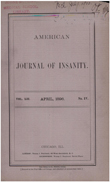Hypnotizability and traumatic experience: a diathesis-stress model of dissociative symptomatology
Abstract
OBJECTIVE: The authors propose a diathesis-stress model to describe how pathological dissociation may arise from an interaction between innate hypnotizability and traumatic experience. METHOD: To support the proposition that pathological dissociation may reflect autohypnotic process, the authors highlight clinical and research data indicating parallels between controlled hypnotic dissociative states and uncontrolled pathological dissociative symptoms and summarize evidence of hypnotizability in persons with psychiatric disorders that manifest these symptoms. The authors present this evidence by examining dissociative symptomatology in four psychological domains: perception, behavior and will, affect, and memory and identity. In addition, modern cognitive and neuropsychological models of dissociation are briefly reviewed. RESULTS: Several lines of evidence converge in support of the role of autohypnosis in pathological dissociation. There is considerable evidence that controlled formal hypnosis can produce a variety of dissociations of awareness and control that resemble many of the symptoms in uncontrolled pathological dissociative conditions; and it is possible to discern in dissociative pathology the features of absorption, dissociation, and suggestibility/automaticity that characterize formal hypnotic states. There is also accumulating evidence of high levels of hypnotic capacity in all groups with dissociative symptomatology that have been systematically assessed. In addition, the widespread and successful therapeutic use of hypnosis in the treatment of many dissociative symptoms and conditions (and the potential for hypnosis to induce dissociative symptomatology) also supports the assumption that hypnosis and pathological dissociation share an underlying process. CONCLUSIONS: High hypnotizability may be a diathesis for pathological dissociative states, particularly under conditions of acute traumatic stress.
Access content
To read the fulltext, please use one of the options below to sign in or purchase access.- Personal login
- Institutional Login
- Sign in via OpenAthens
- Register for access
-
Please login/register if you wish to pair your device and check access availability.
Not a subscriber?
PsychiatryOnline subscription options offer access to the DSM-5 library, books, journals, CME, and patient resources. This all-in-one virtual library provides psychiatrists and mental health professionals with key resources for diagnosis, treatment, research, and professional development.
Need more help? PsychiatryOnline Customer Service may be reached by emailing [email protected] or by calling 800-368-5777 (in the U.S.) or 703-907-7322 (outside the U.S.).



